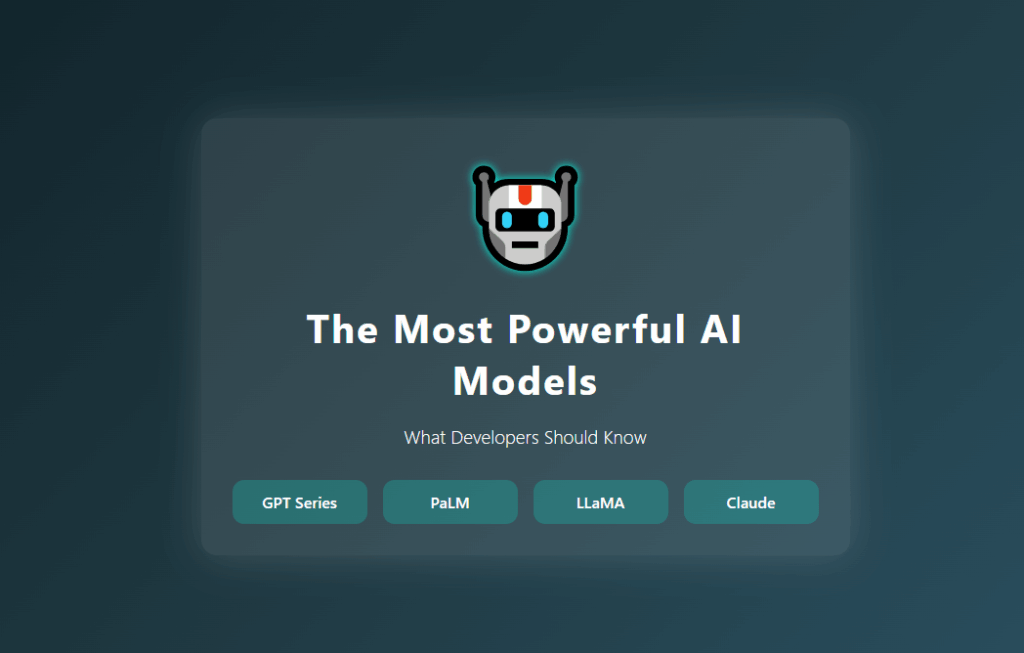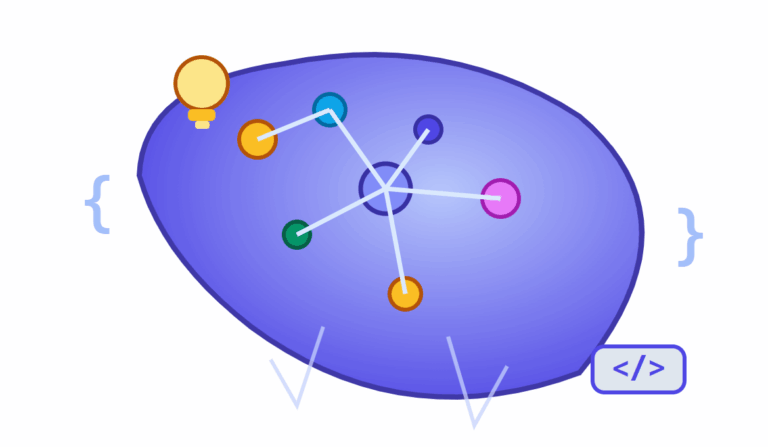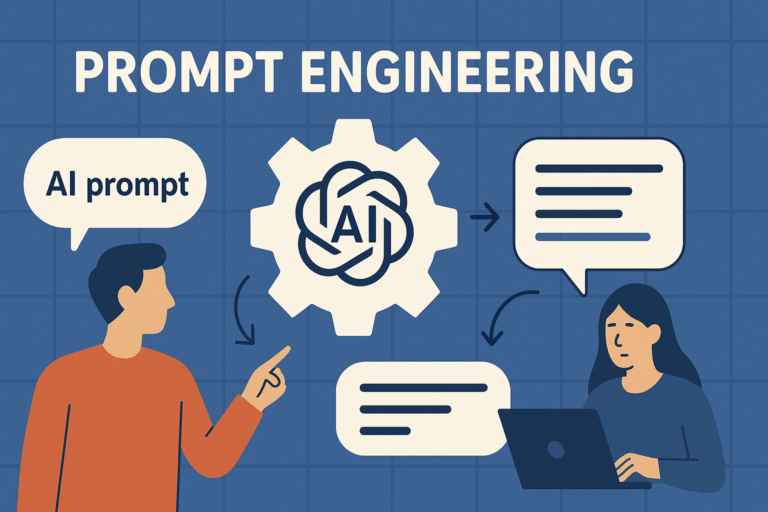The Most Powerful AI Models: What Developers Should Know
Artificial intelligence continues to evolve at lightning speed, but a few cutting-edge models now dominate the field. These large-scale foundation models are the engines behind today’s smartest tools—from virtual assistants and creative apps to enterprise solutions and autonomous systems. Whether you’re building with APIs or deploying your infrastructure, understanding the top AI models that are essential.
Let’s break down the most powerful and popular AI models today, grouped by their primary capabilities.
You can also read >>> Prompt Engineering: How to Get the Best from AI Models
1. Leading Language and Multimodal Models
GPT-4o by OpenAI
OpenAI’s newest flagship, GPT-4o (the “o” stands for “omni”), has transformed the AI landscape. It handles inputs and outputs in text, audio, image, and even video—all through a single unified model. GPT-4o operates with lightning-fast response times close to human conversational speed and costs less than its predecessor, GPT-4 Turbo.
Its biggest strength is seamless multimodal communication, meaning it can process and respond to voice, visuals, and text in a fluid and intelligent way. For developers, this means building truly natural chatbots, digital assistants, and creative tools using just one API.

Claude 4 by Anthropic
Anthropic’s Claude models are known for their safety-first approach and deep reasoning ability. Claude 4, especially the Claude Opus variant, excels at handling extremely long documents—up to 200,000 tokens (around 150,000 words). It also supports images and excels at understanding nuanced instructions.
Claude Sonnet 4 offers similar reasoning strength but with lower latency and cost, making it a great option for real-time applications.
Gemini 1.5 by Google DeepMind
Google’s Gemini models are focused on both performance and scale. Gemini 1.5 Pro is highly competitive with other top-tier models and can process prompts with up to 1 million tokens in testing. This makes it ideal for analyzing large codebases, full-length books, or massive datasets.
Gemini is also multimodal, supporting text and image inputs, and is tightly integrated with Google’s ecosystem.
Llama 3 and 3.1 by Meta
Meta continues its mission to make AI accessible with open-source models. Llama 3 was released in multiple sizes, including an extremely powerful 405 billion parameter model in the 3.1 release. These models are not only competitive with commercial offerings, but they are also open weights, meaning developers can host, fine-tune, and deploy them on their own hardware.
Meta’s open strategy allows developers and businesses to build secure, private AI systems without relying on third-party services.
Mixtral and Mistral Large by Mistral AI
Mistral AI from France has gained popularity for its efficient and cost-effective models. Mixtral 8x22B is a sparse model—only using part of its network per request, making it cheaper and faster to run without sacrificing output quality. Mistral Large supports 128,000 token contexts and is one of the best open-weight models for multilingual reasoning and performance.
For companies looking to self-host high-quality AI, Mistral’s offerings are among the best.

2. Image Generation Models
DALL·E 3 by OpenAI
DALL·E 3 is the go-to model for text-to-image generation. It creates highly detailed, coherent images and excels at tasks like generating illustrations, concept art, or social media graphics. Integrated into OpenAI’s GPT-4o ecosystem, it can generate images within chat interactions without needing a separate tool.
Its ability to follow complex prompts and render readable text in images is a significant upgrade from earlier versions.
Stable Diffusion 3.5 by Stability AI
Stability AI’s latest release continues its mission of open-source generative tools. Stable Diffusion 3.5 produces detailed, high-quality images and can be fine-tuned with custom datasets for branding, creative direction, or niche use cases. Its efficient design makes it suitable for both cloud-based and local deployment, making it a top choice for developers who want control and flexibility.
3. Video and Motion AI Models
Sora by OpenAI
Sora is a groundbreaking model that can generate full video clips from text descriptions. Capable of producing up to 60 seconds of 1080p video, Sora has amazed developers and creatives alike with its realistic lighting, motion, and physics.
Currently in limited rollout, Sora is already powering tools like Bing Video Creator, giving users the ability to make quick, visually rich content for platforms like TikTok, YouTube Shorts, and Instagram.
Video generation is shaping up to be the next big wave in generative AI, and Sora is leading the charge.
4. How to Choose the Right Model
Here’s a simple guide for developers choosing a model based on project needs:
| Use Case | Recommended Models | Key Features |
|---|---|---|
| Conversational Assistants & Chatbots | GPT-4o, Claude Sonnet 4, Gemini 1.5 Pro | Multimodality, speed, safety |
| Document or Code Analysis | Claude Opus 4, Gemini 1.5 Pro, GPT-4.5 | Long-context processing, precision |
| Custom or Private AI | Llama 3/3.1, Mixtral 8x22B, Mistral Large | Open source, self-hostable, fine-tuning ready |
| Creative Imagery & Branding | DALL·E 3, Stable Diffusion 3.5 | Visual fidelity, customization options |
| Short-Form Video or Ads | Sora, Runway Gen-3 | Motion quality, clip length |
Your choice should factor in not just the raw performance of the model but also considerations like hosting, latency, licensing, privacy, and compute costs.
5. What’s Coming Next
The AI landscape is far from static. Here are the trends shaping the future:
- Massive context windows: Soon, working with entire libraries or research datasets will be routine as token limits stretch past 1 million.
- Unified multimodal stacks: We’ll see more models like GPT-4o, which combine all senses (text, vision, audio, and more) into one neural architecture.
- Edge-friendly deployments: Thanks to sparse models and hardware optimization, massive AI models will soon run locally on high-end consumer GPUs.
- Ethical and regulatory alignment: Compliance with global standards like the EU AI Act is pushing companies to adopt transparency, watermarking, and usage safeguards.
More resources to read >>> Prompt Engineering: How to Get the Best from AI Models
Final Thoughts
The leading AI models are more powerful, flexible, and accessible than ever before. Whether you’re a solo developer experimenting with open-source tools or a company building next-generation apps, the right foundation model is out there for you.
Start with GPT-4o or Claude for instant API-based intelligence, or deploy Llama and Mistral models for full control. Use DALL·E or Stable Diffusion for your visual needs, and keep an eye on Sora for the upcoming video boom.
We’re only beginning to tap into what these tools can do. In the future, we will bring even more breakthroughs, and your projects can ride that wave.
More resources to read >>> Prompt Engineering: How to Get the Best from AI Models



